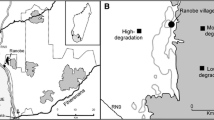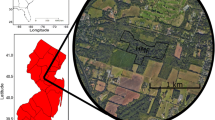Abstract
The unbroken primary rain forest currently covering the interior ofFrench Guiana still offers a unique opportunity to establish a network of largeprotected areas. Bird species richness was surveyed within 20 study areasspreadover the country to assess the relative abundance and frequency of occurrenceofforest interior and natural gap taxa (391 species, excluding raptors andnon-resident birds). Richness, rarity, restricted range, hot spot andconservation value algorithms were used to rank sites in decreasing orders ofimportance and draw sets of survey sites likely to maximize bird diversity. Inmost sets from different methodological approaches, the southern regionconsistently emerged as a priority area for conservation, with the centralmountain range contributing some specialized taxa and the northern regionincorporating additional species, mostly from marginal habitats and moretypicalof the nearby coastal zone. Estimates of areas likely to preserve an almostcomplete sample of the regional biodiversity amounted to about 1–2millionhectares, either in one large area (national park) or divided into 2–3reserves overlapping regional hot spots. However, representation of all speciesand habitats in a protected area system is not an assurance of long-termviability when minimum viable population sizes and demographic patterns arelittle known, and when the risks and impacts of persistent human disturbancessuch as mining, logging and hunting are growing.
Similar content being viewed by others
References
Able K.P. and Noon B.R. 1976. Avian community structure along elevational gradients in the north eastern United States. Oecologia 26: 275–294.
Balmford A. 1998. On hot spots and the use of indicators for reserve selection. Trends in Ecology and Evolution 13: 409.
Bedward M., Pressey R.L. and Keith D.A. 1992. A new approach for selecting fully representative reserve networks: addressing efficiency, reserve design and land suitability with an iterative analysis. Biological Conservation 62: 115–125.
Belbin L. 1993. Environmental representativeness: regional partitioning and reserve selection. Biological Conservation 66: 223–230.
Birdlife International 2000. Threatened Birds of theWorld. Lynx Edicions, Barcelona, Spain and Birdlife International, Cambridge, UK.
Blancanaux P. 1981. Essai sur le milieu naturel de la Guyane Française. Travaux et Documents de l'ORSTOM, Cayenne, 126 pp.
CNRS-ORSTOM 1979. Atlas des departements franc¸ais d'Outre-Mer, Vol. IV, La Guyane. CNRSORSTOM, Bordeaux.
Curnutt J., Lockwood J., Luh H.K., Nott P. and Russell G. 1994. Hot spots and species diversity. Nature 367: 326–327.
Daniels R.J., Hedge M., Joshi N.V. and Gadgil M. 1991. Assigning conservation value: a case study from India. Conservation Biology 5: 464–475.
de Granville J.J. 1979. Végétation Atlas des départements franc¸ais d'Outre-Mer, Vol. IV, La Guyane. CNRS-ORSTOM, Bordeaux.
Diamond J.M. 1978. Critical areas for maintaining viable populations of species. In: Holgate M.W. and Woodman M.D. (eds), The Breakdown and Restoration of Ecosystems. Plenum Press, New York, pp. 27–40.
Faith D.P. and Walker P.A. 1996. How do indicator groups provide information about the relative biodiversity of different sets of areas? On hot spots, complementarity and pattern-based approaches. Biodiversity Letters 3: 18–25.
Flather C.H., Wilson K.R., Dean D.J. and McComb W.C. 1997. Identifying gaps in conservation networks: of indicators and uncertainty in geographic-based analyses. Ecological Applications 7: 531–542.
Franklin I.R. 1980. Evolutionary change in small populations. In: Soulé M.E. and Wilcox B.A. (eds), Conservation Biology. Sinauer Associates, Sunderland, Massachusetts, pp. 135–148.
Gaston K.J. 1996. Biodiversity congruence. Progress in Physics and Geography 20: 105–112.
Gaston K.J., Blackburn T.M., Greenwood J.J., Gregory R.D., Quinn R.M. and Lawton J.H. 2000. Abundance–occupancy relationships. Journal of Applied Ecology 37: 39–59.
Guissan A. and Zimmermann N.E. 2000. Predictive habitat distribution models in ecology. Ecological Modelling 135: 147–186.
Hoff M. 1991. Liste des milieux, habitats et formations végétales de Guyane Collection Patrimoines Naturels. Série Patrimoine Ecologique 5: 1–24. Sécrétariat Faune et Flore, Museum National d'Histoire Naturelle, Paris.
Howard P.C., Viskanic P., Davenport T.R.B., Kigenyi F.W., Baltzer M., Dickinson C.J. et al. 1998. Complementarity and the use of indicator groups for reserve selection in Uganda. Nature 394: 472–475.
Howard P.C., Davenport T.R., Kigenyi F.W., Viskanic P., Baltzer M.C., Dickinson G.J. et al. 2000. Protected area planning in the tropics. Uganda's national system of nature reserves. Conservation Biology 14: 858–875.
Kershaw M., Williams P.H. and Mace G.M. 1994. Conservation of Afrotropical antelopes: consequences and efficiency of using different sites selection methods and diversity criteria. Biodiversity and Conservation 3: 354–372.
Kiester A.R., Scott J.M., Csuti B., Butterfield B., Sahr K. and White D. 1996. Conservation prioritization using GAP data. Conservation Biology 10: 127–134.
Kirkpatrick J.B. 1983. An iterative method for establishing priorities for the selection of nature reserves: an example in Tasmania. Biological Conservation 25: 127–134.
Lombard A.T. 1995. The problems with multi-species conservation: do hot spots, ideal reserves and existing reserves coincide? South African Journal of Zoology 30: 145–163.
Margules C.R. and Nicholls A.O. 1987. Assessing the conservation value of remnant habitat islands: small patches on the western Eyre Peninsula, South Australia. In: Saunders D.A., Arnold G.W., Burbidge A. and Hopkins A.J. (eds), Nature Conservation: The Role of Remnants of Native Vegetation. Surrey Beatty, Chipping Norton, Australia, pp. 89–102.
Margules C.R. and Usher M.B. 1981. Criteria used in assessing wildlife conservation potential: a review. Biological Conservation 21: 79–109.
Margules C.R., Nicholls A.O. and Pressey R.L. 1988. Selecting networks of reserves to maximise biological diversity. Biological Conservation 43: 63–76.
Meyer de Schauensee R. and Phelps W.H. 1978. A Guide to the Birds of Venezuela. Princeton University Press, Princeton, New Jersey.
Nicholls A.O. and Margules C.R. 1993. An upgraded reserve selection algorithm. Biological Conservation 64: 164–169.
Noss R.F. 1990. Indicators for measuring biodiversity: a hierarchical approach. Conservation Biology 4: 355–364.
Prendergast J.R. and Eversham B.C. 1997. Species richness covariance in higher taxa: empirical tests of the biodiversity indicator concept. Ecography 20: 210–216.
Pressey R.L., Humphries C.J., Margules C.R., Vane-Wright R.I. and Williams P.H. 1993. Beyond opportunism: key principles for systematic reserve selection. Trends in Ecology and Evolution 8: 124–128.
Rabinowitz D.R., Cairns S. and Dillon T. 1986. Seven forms of rarity and their frequency in the flora of the British Isles. In: Soulé M.E. (ed.), Conservation Biology. Sinauer Associates, Sunderland, Massachusetts, pp. 182–204.
Reid W.V. 1998. Biodiversity hot spots. Trends in Ecology and Evolution 13: 275–280.
Reyers B., van Jaarsveld A.S. and Krüger M. 1999. Complementarity as a biodiversity indicator strategy. Proceedings of the Royal Society London, Series B 267: 505–513.
Ridgely R.S. and Tudor G. 1989–1994. The Birds of South America,Vols. I and II. Oxford University Press, Oxford.
Rodrigues A.S., Cerdeira J.O. and Gaston K.J. 2000. Flexibility, efficiency, and accountability: adapting reserve selection algorithms to more complex conservation problems. Ecography 23: 565–574.
Ryti R. 1992. Effects of the focal taxon of the selection of nature reserves. Ecological Applications 2: 404–410.
Saethersdal M., Line J.M. and Birks H.J.B. 1993. How to maximise biological diversity in nature reserve selection: vascular plants and breeding birds in deciduous woodlands, western Norway. Biological Conservation 66: 131–138.
Schwartz M.W. 1999. Choosing the appropriate scale of reserves for conservation. Annual Review of Ecology and Systematics 30: 83–108.
Scott J.M., Davis F., Csuti B., Noss F., Butterfield B., Groves C. et al. 1993. Gap analysis: a geographic approach to protection of biological diversity. Wildlife Monographs 123. The Wildlife Society, Bethesda, Maryland.
Shaffer C.L. 1990. Nature Reserves. Island Theory and Conservation Practice. Smithsonian Institution Press, Washington, DC.
Shaffer M.L. 1987. Minimum viable populations: coping with uncertainty. In: Soulé M. (ed.), Viable Populations for Conservation. Cambridge University Press, Cambridge, UK, pp. 69–86.
Templeton A.R. 1995. Biodiversity at the molecular genetic level: experiences from disparate microorganisms. In: Hawksworth D.L. (ed.), Biodiversity. Measurement and estimation. Chapman & Hall, London, pp. 59–64.
Terborgh J. and Andresen E. 1998. The composition of Amazonian forests: patterns at local and regional scales. Journal of Tropical Ecology 14: 645–664.
Thiollay J.M. 1985. Raptor community structure of a primary rain forest in French Guiana and effect of human hunting pressure. Raptor Research 18: 117–122.
Thiollay J.M. 1994. Structure, density and rarity in an amazonian forest bird community. Journal of Tropical Ecology 10: 449–481.
Thiollay J.M. 2002. Large scale bird distribution and diversity patterns across a tropical forest landscape (French Guiana). Journal of Tropical Ecology (in press).
Underhill L.G. 1994. Optimal and suboptimal reserve selection algorithms. Biological Conservation 70: 85–87.
Vane-Wright R.I., Humphries C.J. and Williams P.H. 1991. What to protect? Systematics and the agony of choice. Biological Conservation 55: 235–254.
Williamson M. 1988. Relationship of species number to area, distance and other variables. In: Myers A.M. and Giller P.S. (eds), Analytical Biogeography. Chapman & Hall, London, pp. 91–115.
Williams P.H. and Araujo M.B. 2000. Using probability of persistence to identify important areas for biodiversity conservation. Proceedings of the Royal Society London, Series B 267: 1959–1966.
Williams P.H. and Gaston K.J. 1994. Measuring more of biodiversity: can higher taxon richness predict wholesale species richness? Biological Conservation 67: 211–217.
Williams P.H. and Gaston K.J. 1998. Biodiversity indicators: graphical techniques, smoothing and searching for what makes relationship work. Ecography 21: 551–560.
Williams P.H., Gibbons D., Margules C., Rebelo A., Humphries C. and Pressey R. 1996. A comparison of richness hot spots, rarity hot spots and complementary areas for conserving diversity of British birds. Conservation Biology 10: 155–174.
Author information
Authors and Affiliations
Rights and permissions
About this article
Cite this article
Thiollay, JM. Bird diversity and selection of protected areas in a large neotropical forest tract. Biodiversity and Conservation 11, 1377–1395 (2002). https://doi.org/10.1023/A:1016269813160
Issue Date:
DOI: https://doi.org/10.1023/A:1016269813160




